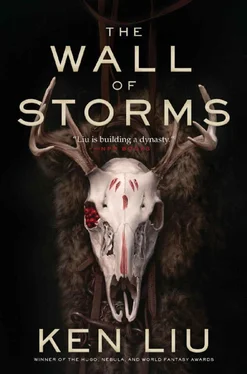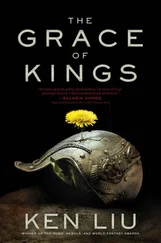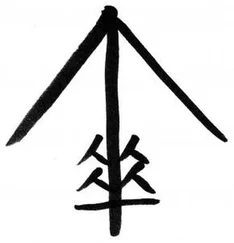In the gondola of the Lyucu ship, Pékyu Vadyu almost collapsed to the floor. It had taken every ounce of self-control for her not to leap across the gap between the two gondolas to seize the string of tolyusa hanging around Zomi Kidosu’s neck. And the baby was kicking inside her, possibly in reaction to her stress and adding to her discomfort.
The tolyusa was a plant native to Ukyu and Gondé, and critical to the life of both the people of the scrublands and the garinafins. A spicy plant whose fragrance and flavor resembled fire, the berries were a powerful hallucinogen used in the religious ceremonies honoring the All-Father, Every-Mother, and their many children.
Even more important, the tolyusa was critical to the reproductive cycle of the garinafins. Females had to consume large quantities of tolyusa berries to give birth to healthy young. Because the berries had such powerful hallucinogenic effects and the Lyucu did not want the garinafins to give birth to many babies during the long voyage from Ukyu to Dara, Pékyu Tenryo had kept the supply of tolyusa all on his ship in a secured storeroom. That was the room that Luan Zya had burned down.
Throughout the negotiations with Empress Jia, the pékyu had struggled to present a false image of confidence and power. Because they were cut off from the tolyusa, the garinafins had not been able to give birth to new hatchlings since their arrival in Dara. The adults were growing increasingly unruly, and if a new supply couldn’t be found soon, Pékyu Vadyu was going to be forced to execute some of the garinafins for safety reasons.
But now, the gods had smiled upon the Lyucu. There was tolyusa in Dara.
CRESCENT ISLAND: THE FIRST MONTH IN THE FIRST YEAR OF THE REIGN OF SEASON OF STORMS.
The hamlet at the foot of the towering cliff was slumbering in deep winter.
Képulu and Séji were outside stuffing snow into a bucket to be boiled into water. From time to time they stopped to take in the winter landscape around them. The branches of the towering trees at the edge of the clearing were laden with snow and sagged slightly. They could see almost no signs of the fire that had devastated the land a dozen years ago.
Nature healed fast.
The sound of beating wings drew their attention. As they looked up, a great winged beast burst from the clouds—serpentine neck, leathery wings, antlered head, and cold, pupilless eyes—and headed for the cliff behind the hamlet. To their amazement, they saw tiny figures—people—riding on the back of the strange creature.
The beast swept over their heads and disappeared over the top of the cliff. The two women looked at each other and ran through the snow to report what they had seen to Elder Comi, the bucket forgotten in the snow behind them.
Taking off daily from the deck of a city-ship that hugged the northern coast of Crescent Island, the Lyucu expedition had been scouring the island for tolyusa for weeks. The riders and their mount were both growing impatient due to the lack of success. Usually they limited their flights to dawn or dusk, but with the spring hunting season just around the corner, they took risks to search for the tolyusa during broad daylight. They needed to find what they came for before the minor nobles of Dara arrived on the island in search of boar tusk trophies and interpreted their incursions into Crescent Island as an act of war.
The garinafin jerked and dove suddenly. The pilot tapped the neck of the garinafin to ask it to slow down, but the garinafin responded only by diving even faster. The riders and the pilot had no choice but to hang on tight to their harnesses as they descended at a dizzying speed.
The garinafin landed in a clearing in the woods on top of the cliff and bellowed triumphantly.
The Lyucu riders looked around them, dazed.
The garinafin was standing in the middle of what appeared to be a fresh lava flow that cut through the pure white, snow-covered clearing. The strong smell of fire and smoke only added to the impression. But a closer examination revealed that the “lava” was made from a carpet of plants whose leaves, stems, and flowers were all bright red. The tolyusa was a hardy plant that flowered in winter, and berries would come in the spring.
The Lyucu warriors climbed down from the garinafin, fell down to their knees, and wept tears of joy. In the heart of winter, they had found the hope for renewal.
“The All-Father protects us!”
“Praise be to the gods of this new land!”
Years ago, when Pékyu Tenryo had sent his exploratory expeditions to Dara, one of his ships had tried to pass through the Wall of Storms. The ship had been wrecked, but the supply of tolyusa they carried as a way to speak to the gods on the long journey had survived, washed ashore, passed through the guts of birds and animals until the seeds took root here, in the most inhospitable volcanic rock of the Islands of Dara.
SOMEWHERE OFF THE COAST OF NOKIDA: THE FIRST MONTH IN THE FIRST YEAR OF THE REIGN OF SEASON OF STORMS.
A fleet of small boats from the Itanti Peninsula closed in on the dome-headed whale to the east of Nokida.
This was the Year of the Whale, and winter was the season for whale hunting.
The whales, fat with blubber, migrated to the southern oceans to breed. Along the way, pods of whales passed by Wolf’s Paw, the southeastern corner of the Big Island, and the Tunoa Isles. Fishermen who were brave enough to take up the harpoon and join one of the hunting fleets could look forward to a share of the rich profits to be made from blubber, meat, and whalebone, all of which fetched good prices in Dara.
The rowers on the small, slender boats, each about twenty feet long, strained in synchrony and propelled the boat to glide over the choppy sea as fast as a flying dyran. A young man stood at the prow of the boat, holding up a harpoon like a vision of Tazu.
The boat was closing in on the bobbing black figure of the whale glimpsed through the waves.
“I got it!” the young man cried, and with a grunt, heaved the harpoon. The weapon plunged into the back of the whale and the line trailing from it began to unspool at a rapid pace.
“A strike! A strike!” the crew of the whaleboat called out to the other boats. While the line continued to unspool, they reversed themselves in the boat and began to row the other way as the other boats closed in.
The largest and most desired whale to hunt was the dome-headed whale, so named for its large, bulbous forehead, which contained a large melon of wax that had been prized since ancient times as a lubricant and the base ingredient in many cosmetics. It was said that the whale was able to melt and freeze the wax in the melon as a way to adjust its buoyancy in water—a kind of watery equivalent to the gas sacs of the garinafin, perhaps.
The specimen the fleet was chasing today was a male of average size, about fifty feet in length.
When the other boats were close enough, the crews tossed over cables with hooks, which the harpoon boat’s crew used to secure the boats together. Soon, the five boats in the hunting pack were strung together like a line of fish, and the cable attached to the harpoon was about to run out.
“Get ready!” the young man shouted, and sat down inside the boat to brace himself as the line ran out and the force of the whale jerked the entire line of boats almost out of the water. “Brace!” he shouted again.
Читать дальше














